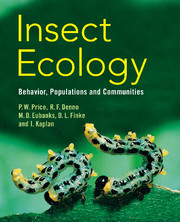Book contents
- Frontmatter
- Contents
- Preface
- Acknowledgments
- Part I Introduction
- Part II Behavioral ecology
- Part III Species interactions
- Part IV Population ecology
- Part V Food webs and communities
- 12 Community structure
- 13 Multitrophic interactions
- Part VI Broad patterns in nature
- Glossary
- References
- Author Index
- Taxonomic Index
- Subject Index
- Plate section
- References
12 - Community structure
from Part V - Food webs and communities
Published online by Cambridge University Press: 05 June 2012
- Frontmatter
- Contents
- Preface
- Acknowledgments
- Part I Introduction
- Part II Behavioral ecology
- Part III Species interactions
- Part IV Population ecology
- Part V Food webs and communities
- 12 Community structure
- 13 Multitrophic interactions
- Part VI Broad patterns in nature
- Glossary
- References
- Author Index
- Taxonomic Index
- Subject Index
- Plate section
- References
Summary
In this chapter we consider what a community really is and how we conceptualize the composition of the community. We discuss the ecological niches of species and how communities develop through colonization of resources and the ecological succession of species through time. This leads to views on organizing factors contributing to community structure and how species become assembled into associations of species. We note that some herbivore communities apparently illustrate rules of assembly based on the genetic composition of the host plant, but others may be influenced mostly by resources such as their heterogeneity, their quality or quantity, or by natural enemies. We then move on to the comparison of the numbers of species in communities, considering time and area as variables which contribute to richness on different host-plant species. Finally we discuss complex communities with all species that interact recognized as playing a role: from plants to detritivore-based food webs, herbivore and natural enemy food webs, and up to the top predators in the system.
The community
Various concepts of the community coexist in the literature: “the organisms that interact in a given area” (Price 1997, p. 21); “an assemblage of populations that coexist in an area” (Root 2001, p. 295); “the total living biotic component of an ecosystem, including plants, animals and microbes. The term . . . implies interaction between the individuals and species . . .” (Moore ,1998 p. 145). Morin (1999) discusses the concept at length, with it being so entrenched in the ecological lexicon that almost any view is viable and acceptable. In this book we prefer to emphasize interactions among species as a necessary criterion of the community, just as interaction is the cornerstone of human communities, a comparison first noted by Elton (1927).
Information
- Type
- Chapter
- Information
- Insect EcologyBehavior, Populations and Communities, pp. 443 - 488Publisher: Cambridge University PressPrint publication year: 2011
